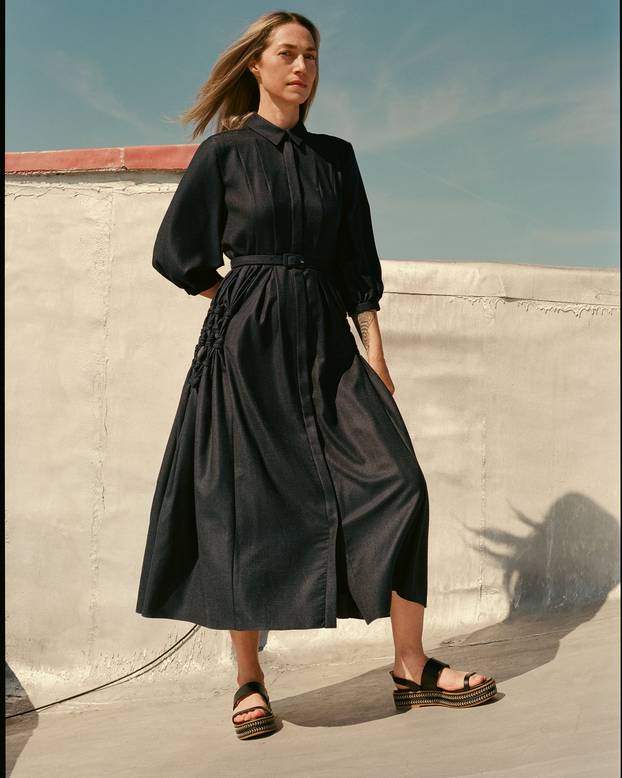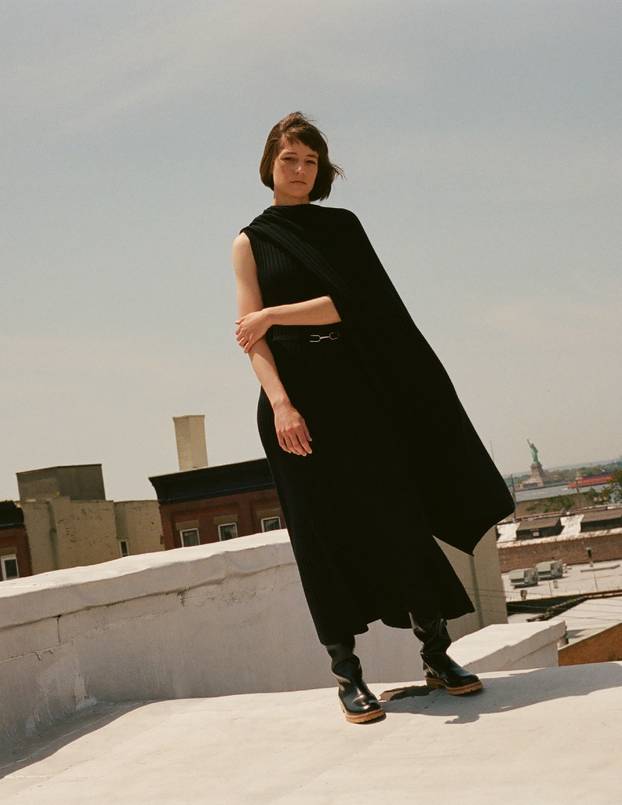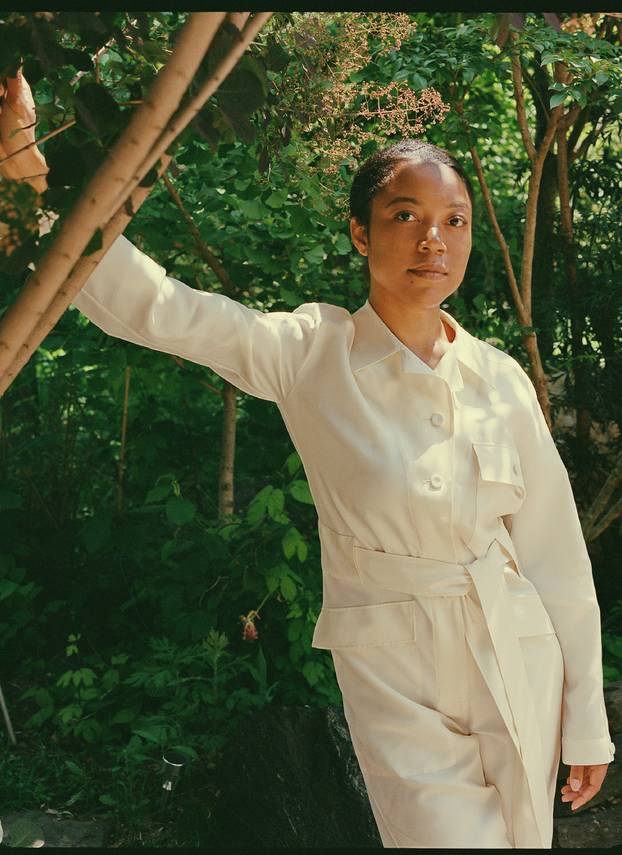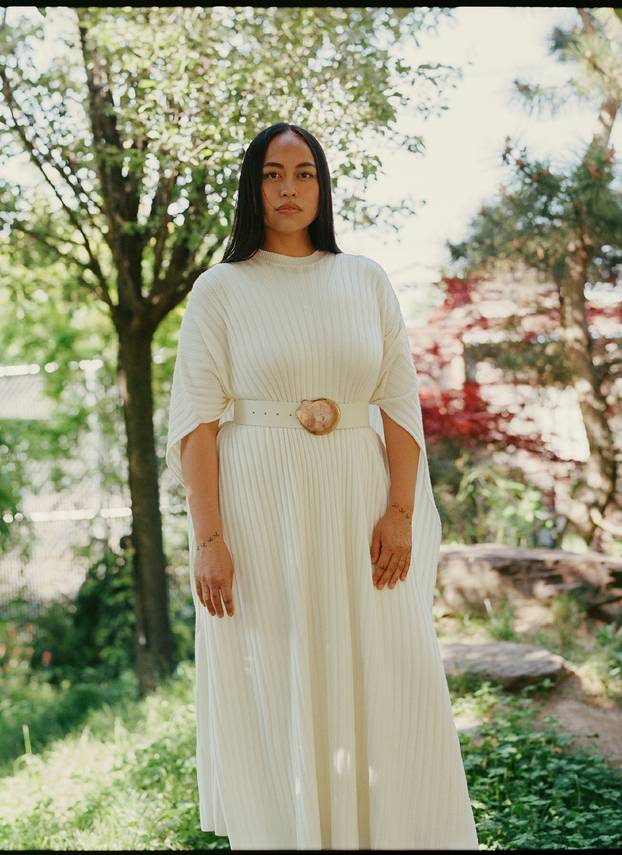Pre-Fall 2021 Collection | Pioneer Works Resident Artists

For Gabriela Hearst’s Pre-Fall 2021 Collection, we photographed four artists in partnership with Pioneer Works, a Brooklyn-based cultural center with a robust artistic residency program.
Below, their interviews in full.
GENESIS BELANGER
Sculptor, 2017 Visual Arts Resident at Pioneer Works
How do you describe your work?
Genesis Belanger: I say that I’m a sculptor who builds installations, and I often use those installations as an opportunity to investigate different power structures, and consumerism, and themes that have an impact on our culture, or [are] in dialogue with what's going on in the world around me. I'm finishing a show now [that sought to] investigate ideas around romance...how absurd these gendered ways that women are reduced in a romantic context.
People sometimes ask, "What does art do?" Or, "What can art do?" And I think maybe one of the things that art can do is start a conversation. My hope is that I make things that are just familiar enough to be a little bit uncanny and uncomfortable, and then make the viewer think about themselves and their own experiences. And then perhaps start a conversation that could address some of these broader, bigger questions about culture, [like the expectation of women's roles in society and romance].
Genesis Belanger has two solo shows opening in July: Perrotin, Tokyo (July 15-17, 2021), and Le Consortium in Dijon, France (July 7, 2021 – January 9, 2022). Follow her on Instagram, @genesisbelanger.
KARA GÜT
Video Artist, and 2021 Pioneer Works Technology Resident
How do you describe your work?
Kara Güt: I'm a video artist. I work with a lot of video and new media and video games. I work a lot with performance as well - not traditional performance, body performance - but using avatars in digital space as a stand-in for the body. I use a lot of video game imagery and usually that video game imagery is fantasy RPG games and medieval aesthetics.
I'm interested in the translation of the digital back into the physical. So the loss of translation between the object and digital space, and then what actually occurs in physical space once you take it out.
Tell us about your most recent project.
Kara Güt: Right now I'm writing a play within a video game. It will be performed, live, inside of an online video game with four actors. I started this project before the pandemic, but I think people understand what I'm talking about more now: relating to people in digital space. Also it can be very isolating, so I'm talking about all of that in my work.
I'm working with people who are amateur actors, and primarily gamers first. I am really interested in fan experience and how fans relate to the source material, so I was really interested in having them design their own avatars and dress themselves. [I was interested to see] whether they were going to recreate themselves exactly--make themselves look exactly like they would in real life, or if they decided to go completely off the map and make a completely different character and embody someone totally different.
What about when you create avatars for yourself? Do you like your avatar to look like you, or do you prefer to step outside yourself?
Kara Güt: I usually like to be someone else. And I don't know if that's on purpose. I haven't really read into that personally, but usually I just...I'm a huge fan of pressing the "randomize" button and seeing what the universe gives me. I find that kind of exciting.
Check out Kara Güt on her website, Karagut.info, follow her on Instagram, @baby_peach123456789, and explore Kara Güt’s March 2021 show in collaboration with Clare Gatto, https://www.stonehouseartgallery.com/spawning-point. Kara Güt’s Fantasy Font Catalog, in partnership with New Archive, is available for purchase at NewArchive.co.


ARI MELENCIANO
Designer, Creative Technologist, Researcher, Professor, Founder of Afrotectopia, and 2020 Technology Resident at Pioneer Works
How do you describe your work?
Ari Melenciano: Right now I'm a professor at New York University, and I also am a technologist at Google's Creative Lab.
Last year, I was an artist-in-residence at Pioneer Works, focusing on technology. I was exploring how sound can be composed through computer vision--like creating a relationship between different visuals and sounds through the camera. I was also exploring new ways of experiencing sound, spatializing sound within an environment, experimenting with the ways sounds are positioned in space while listening affects the way it's perceived. I’m continuing to do a lot of sound work and exploration of sound.
A lot of my work surrounds technology and creative approaches to technology, so we call it “creative technology.” I think the most exciting part about entering this field of creative technology is that, as an artist, and as an educator, I'm always in a space that's in dialogue with a lot of different people.
And as a founder of a whole institution [Afrotectopia], it's about finding a way to create a space and an environment for people to enjoy that space and feel in awe and excited and inspired, but also allow them to have agency to make it what they need it to be for them.
With understanding that your work is about creating dialogue between you and the viewer, how do you think about your art as it relates to your own personal self-expression?
Ari Melenciano: I’m realizing that as an artist, I'm just a vessel. These ideas and ways of thinking: they're all just coming through me. And it's really a matter of finding a way to express that, because I really enjoy experiencing it internally. So how can I make that an outward experience for someone else to experience and understand? It’s also about realizing that life and energy is very interconnected.
I'm also thinking a lot about Black life and me just wanting to be a mirror to others, and specifically, racially, of the beauty of Blackness. It’s also about exploring different ways that we can live. This is a way that we can imagine the world to be, and presenting those really important alternatives, because oftentimes Black people really don't get to see examples of that. Overall, my art is very much a self-expression, but it's also realizing it's not an expression of just myself, but of us, and that there's something else that's coming through beyond me and outside of my control. And that it's meant to be a space for people to engage in paradigm shifts and explore new ways of experiencing life.
One of my more recent projects was creating an online virtual healing environment: tapping into how certain sonic and light frequencies can actually tie into different energy centers or chakras that you have, and experiencing that sound and color as a healing modality. ...So much of my work is trying to create moments where people remember how beautiful life is.
Ari Melenciano’s personal work can be found on her website, AriCiano.tv, and Instagram, @ariciano. Exciting things are on their way for Afrotectopia (@afrotectopia and Afrotectopia.org), a social institution created by Ari that is “building at the nexus of art, design, technology, and science through an Afrocentric lens.”
Caroline Garcia
Interdisciplinary Artist (Performance, Video, Installation), and 2021 Technology Resident
As an artist, you are the hands, the eyes, the mouth, the brain, creating the vision. Was it strange to be on the other side of the creative process as the subject in a photoshoot?
Caroline Garcia: Often, I am in my artwork. I have control of my own image and I am very intentional with how I use my body and its representations to address politics. So I actually use my body as a tool to comment on identity, race, and gender in my work.
I have been in other people's works before, and I'm usually happy to offer to be a body in their work, as long as I agree with their particular project or what they’re trying to communicate. So I generally feel quite comfortable having my image in someone else's work, and when everything aligns it's really interesting to be transformed for someone else's concept or for someone else's aesthetic.
Can you tell me a little bit about the piece you just finished installing?
Caroline Garcia: It's a commissioned work for The Shed Open Call 2021 exhibition. It’s an installation that borrows the dimensions of a boxing ring. It has a lot of different components: ceramics, plants, audio. It includes video: the documentation of a performance that I did inside of the installation, [which] involves body camera footage and green screening. And then that has augmented reality around it: I co-authored a text with a Filipino martial arts women's collective that I train with, Chrysalis Kali Collective. I worked with Tommy Martinez, the director of Pioneer Work’s Tech Residency, on this augmented reality element.
[The installation] asks of you to try and access a different way to approach grief, which is what this work is about. I explore grief through the Indigenous practice of headhunting, which is the ritual act of decapitation that has been historically salient in the Philippine Islands...I’m thinking about headhunting and grief and rage, and how that can manifest from my own experiences with personal loss, specifically the passing of my mother, to come to a place of potential healing, and for that even to be extended as a collective healing practice when it comes to postcolonial diasporic grief, through and by way of Filipino martial arts.
It's not a very obvious method, particularly in Western practices, to deal with grief. So this very, very much is borrowing from an indigenous rationale. Being from the Filipinx diaspora in Australia, this is also a way for me to return to indigeneity and to mobilize it, but also at the same time, try and create these possible new experiences of a very specific diasporic identity that is separate to indigenous roots. And doing so definitely does return to the traditional source, but also moves the diaspora forward, in an unconventional way.
Caroline Garcia’s Installation at The Shed runs June 4 - August 1, 2021. Visit her website, CarolineGarcia.com.au, for more information on upcoming shows, and follow her on Instagram, @_garciagram.


